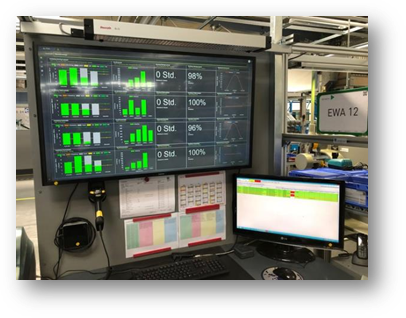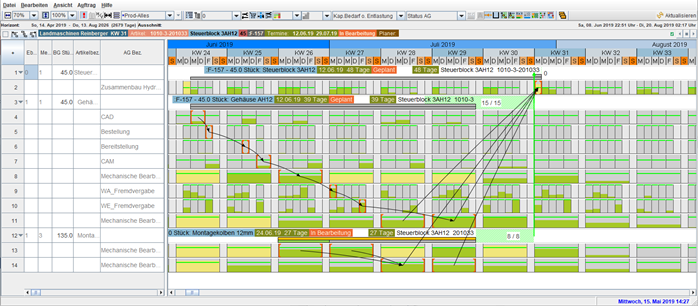How to implement task-based production

Implement task-based production, even with complex manufacturing
In the effort to keep up with continuously rising demands for order-related production with fast delivery times, maximum on-schedule delivery and growing product variety, many businesses find themselves faced with enormous challenges. Schedule adherence is increasingly becoming a crucial success factor in this pursuit. In addition to lean production, everyone’s tossing around terms like Industry 4.0, decentralized organization and job shop production. Many companies are opting for more personal responsibility, a more agile approach and more flexible structures. Key characteristics include flat management structures, clearly delineated areas of responsibility (product and process orientation) and self-organized, semi-autonomous units.
Conventional planning systems have their limits
Conventional planning systems are based on deterministic, down-to-the-minute detailed planning and don’t allow for any personal responsibility in execution. The enormous volumes of data take a vast amount of effort to update, while the quality of the planning data is often poor. In make-to-order production, detailed planning is often altogether impossible. The result is down-to-the-minute deadlines, low acceptance, shadow systems and finger-pointing. In other words, if orders aren’t ready on time, it’s the Planning Department’s fault.
Join the complete webinar series
Here’s how task-based planning works
The innovative approach known as task-based planning brings the advantages of flow orientation to production with a wide variety of parts and complex material flows. Orders are planned and scheduled based roughly on predefined time frames (tasks.) Scheduling synchronization of the task times and capacity-reviewed planning let the work center groups know what their mutually coordinated and feasible orders are per task.
At the operative level, workers then take responsibility for implementing order controlling and order processing within the task rates. cc|task-based planning offers various levels of detail in areas such as detailed planning, controlling and shop floor management, so that the execution level always operates at the right pace and is able to respond immediately to any failures or deviations. The result? – Much greater reliability, plus the schedule performance you need.
Responding quickly and flexibly to changes of plan
Having multiple teams working at the same task rate along the value chain, design engineering and extended workbench ensures that the entire production process runs in sync and at the same flow rate. Task-based rough planning allows for reliable timelines and delivery date calculation that factors in capacity and materials. It also prevents unrealistic planning. Based on simulations, planners can identify potential bottlenecks and under-capacity utilization before they start with order planning.
The capacity model with flexible capacity limits and signal light control allows your business to flexibly adapt its capacities to demand and utilization. In case of scheduling, capacity or volume changes, simply drag & drop the inputs to reorganize the plan. At any point, you can also simulate and evaluate the effects on the current order situation. Task-based detailed planning and control mechanisms allow the team to plan sequences, machine loads and personnel deployment. Using this method, you can give your workers the freedom they need to respond to problems quickly and independently within the required basic dates.
The graphical user interface lets you display parameters such as order backlog, sequence or order status with just one click. As a result, you can keep an eye on your entire production line and enjoy maximum transparency.
Download matching
Whitepaper
Conclusion
A task-based approach to planning and production offers flexibility and a better overview of current and future capacity utilization. Task-based planning allows your staff to variably schedule, calculate and generate processing times, work plans and requirement quantities. And task-based production provides optimal support. Finally, with the visual work method and easy-to-use graphical planning interface, you won’t have to worry about employee acceptance. The interaction of planning and execution is maximally optimized using centralized rough planning, decentralized detailed planning and centralized synchronization of deadlines.
Would you consider using a task-based approach, or have you already had the opportunity? Our seasoned industry management experts have some great tips to offer. Make an appointment with Michael Hering today to discuss your specific situation.
Want to learn more about task-based planning? Read our white paper for more details on this highly efficient planning method.


